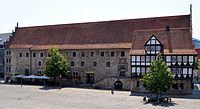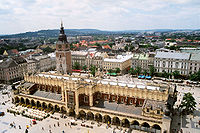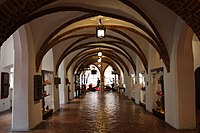Cloth hall
A cloth hall or linen hall (German: Gewandhaus; Polish: Sukiennice; French: Halle aux draps; Dutch: Lakenhal) is a historic building located in the centre of the main marketplace of a European town. Cloth halls were built from medieval times into the 18th century.
A cloth hall contained trading stalls for the sale, particularly, of cloth but also of leather, wax, salt, and exotic imports such as silks and spices.
Belgium
[edit]


Examples of cloth halls in Belgium include the Ypres Cloth Hall and cloth halls in Bruges, Leuven, and Tournai. Leuven's Linen-Hall is in an early-Gothic style, with baroque addition, and now serves as the Leuven University Hall.
- Antoing: the former town hall had been built as a cloth hall in 1565
- Bruges: Kontor of Bruges
- Brussels, see Drapery Court of Brussels
- Dendermonde: Belfry of Dendermonde
- Diest: Cloth Hall of Diest
- Tournai: Cloth Hall of Tournai
- Geel: former city hall
- Ghent: Belfry of Ghent
- Halen: on the site of the current town hall
- Hasselt: Cloth Hall, since the 18th century Meeting House of the Literary Society
- Heestert: Lakenhalle OLV Hemelvaart
- Herentals: Belfry of Herentals
- Ypres: Ypres Cloth Hall
- Kortrijk: Great Cloth Hall, destroyed in 1944, now Schouwburgplein.
- Langemark: 1296–1344, destroyed by Ypres weavers
- Leuven: University Hall (Leuven)
- Lier, Belgium: the current Town Hall of Lier.
- Maaseik
- Mechelen: Town Hall of Mechelen
- Nieuwkerke, demolished in 1844
- Oudenaarde: Oudenaarde Town Hall
- Sint-Truiden: Belfry of Sint-Truiden
- Tielt: Belfry of Tielt
- Turnhout: old Town Hall of Turnhout on Herentalsstraat, demolished in 1962
- Zinnik
- Verviers
- Zoutleeuw: Cloth Hall of Zoutleeuw
Britain and Ireland
[edit]British examples are Drapers' Hall, London; the Piece Hall, Halifax; and Leeds' White Cloth Hall.
-
Piece Hall (cloth hall), Halifax, England
-
Surviving part of Leeds' 3rd White Cloth Hall (opened 1775)
In Ireland, the Dublin Linen Hall was completed in 1728, and later White Linen Hall was constructed in Belfast.[1] The Linen Hall Library is located in this area. There were linen halls in other towns such as Castlebar (which includes Linenhall Arts Centre) and Clonakilty.
Germany
[edit]Examples of German Gewandhäuser can be found in the towns of Brunswick, Zwickau, and Leipzig.
The rebuilt, third Leipzig Gewandhaus is home to the Leipzig Gewandhaus Orchestra.
-
Gewandhaus (Cloth Hall) in Brunswick, Germany
-
Gewandhaus (Cloth Hall) in Zwickau, Germany
-
Rebuilt, third Leipzig Gewandhaus concert hall (opened 1981)
Netherlands
[edit]
The former Cloth Hall in Leiden, Netherlands, has, since the 19th century, housed the Museum De Lakenhal (Municipal Cloth-Hall Museum) of art.
- Amsterdam: cloth hall Groenburgwal, nowadays an Anglican church named Christ Church (Amsterdam)
- Echt, Netherlands
- Deventer: Wanthuis, part of the Deventer town hall since the 15th/16th century.[2]
- Dordrecht: later called Huis Scharlaeken.[3] Demolished in 1858. The Watersteinstoren used to be part of it for a time.
- Leiden: Laecken-Halle, see Museum De Lakenhal
- Maastricht: Cloth hall at the Market square; linen weavers mainly resided in the Boschstraatkwartier
- Middelburg, Zeeland
- Nijmegen: Gewandhuis/Lakenhal, Great Market square 22–25; the current Kerkboog is a remnant of it.[4]
- Sittard: at the Market square, destroyed
- Weert. Weerter cloth was also traded in the Halle van Weert in Hoogstraat in Bergen op Zoom and stored in De Stadt van Weert in Reijnderstraat in Antwerp.[5]
Poland
[edit]In Poland, the most famous existing cloth-hall building is Kraków's Cloth Hall (Sukiennice), rebuilt in 1555 in Renaissance style.[6] The 14th-century Gothic cloth hall in Toruń is preserved as part of the Old Town Market Hall.
Cloth halls formerly also existed in Poznań, at the Old Market Square; and in Wrocław, at the site of the street now called ulica Sukiennice (Cloth-Hall Street).
Notes and references
[edit]- ^ Hopkins, Frank (4 September 2008). "The Very Fabric Of Dublin's Past". Irish Independent. Retrieved 31 August 2021.
- ^ Ter Kuile, E.H., & Koch, A.C.F. (1964). Zuid-Salland. Den Haag: Staatsuitgeverij, geraadpleegd van DBNL
- ^ Herwaarden, J., de Boer, D. P., van Kan, F., & Verhoeven, G. (1996). Geschiedenis van Dordrecht tot 1572, pp. 29-30. Gemeentearchief Dordrecht
- ^ "Nijmegen §2.1 Wereldlijke bouwkunst". Encarta Encyclopedie Winkler Prins (in Dutch). Microsoft Corporation/Het Spectrum. 2002.
- ^ J.F.A. Wassink (2005). Van stad en buitenie. Hilversum: Uitgeverij Verloren. p. 280. ISBN 90-6550-850-3. Retrieved 11 April 2023.
- ^ The World's Best Squares, PPS website, Making Places, December 2005








